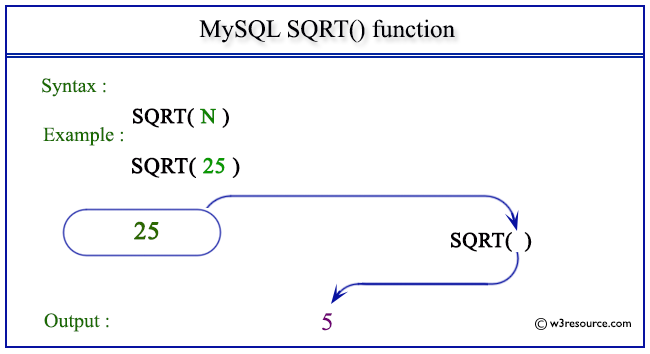MySQL SQRT() function
SQRT() function
MySQL SQRT() returns the square root of a non-negative number of the argument.
This function is useful in -
- In geometry and trigonometry, SQRT() is frequently used to calculate distances, lengths, and dimensions of shapes and figures.
- SQRT() is used to compute the square root of variances, which are key measures in statistics for understanding the spread or dispersion of data points.
- Engineers and physicists use SQRT() to analyze and model physical systems.
- In finance and economics, SQRT() can be used to calculate standard deviations, which are crucial in risk assessment, portfolio management, and investment strategies.
- In many scientific and engineering applications, it's important to estimate or quantify errors or uncertainties.
- SQRT() is useful for validating input data or for checking the validity of certain calculations, particularly when dealing with physical or real-world measurements.
- SQRT() can be employed in data preprocessing or feature engineering steps where scaling or normalizing data is necessary.
- In computer graphics and visualization, SQRT() can be used to calculate dimensions, distances, and sizes of objects, as well as to handle transformations.
Syntax:
SQRT(X)
Where X is a number
Syntax Diagram:

MySQL Version: 8.0
Pictorial presentation of MySQL SQRT() function

Example of MySQL SQRT() function
Code:
SELECT SQRT(25);
Explanation:
The above statement will return the square root of the given number 25.
Output:
mysql> SELECT SQRT(25); +----------+ | SQRT(25) | +----------+ | 5 | +----------+ 1 row in set (0.00 sec)
Example: SQRT() function using negative value
Code:
SELECT SQRT(-25);
Explanation:
The above statement will return NULL because the value of the argument (-25) is negative.
Output:
mysql> SELECT SQRT(-25); +-----------+ | SQRT(-25) | +-----------+ | NULL | +-----------+ 1 row in set (0.00 sec)
